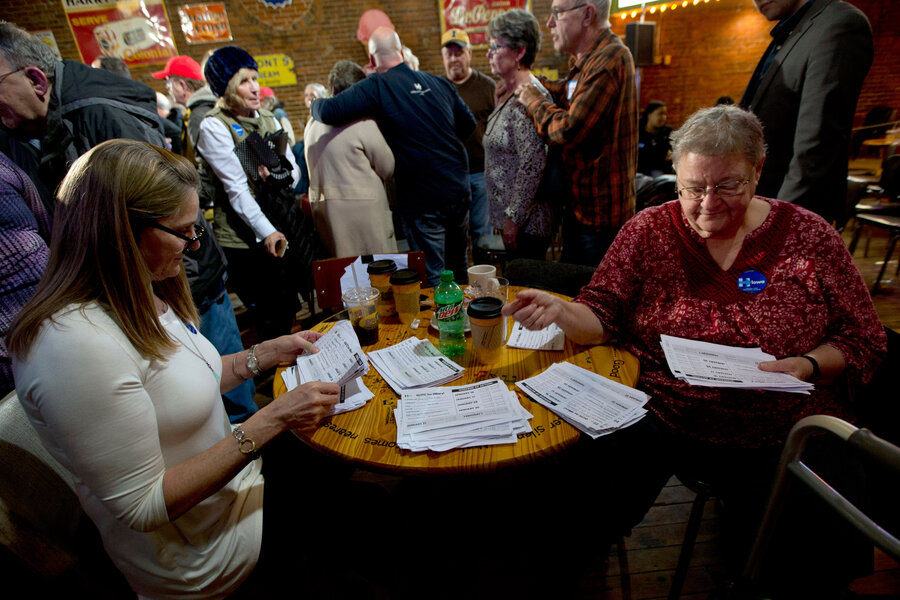How did the Iowa caucuses get to be such a big deal?
Loading...
How did the Iowa caucuses become The Iowa Caucuses – the kickoff to the American presidential election cycle and a key influence on the political race to come?
There are two interrelated answers to that question. The first is logistical. The second is “Jimmy Carter,” but perhaps not in the way you think.
The first thing to remember is that Iowa has always been a caucus state, in which delegates to national party conventions are chosen by people meeting and talking. Or almost always – early in the 20th century, the Hawkeye State did try a primary voting approach, but not that many people showed up and it was deemed too expensive in light of the result.
But for much of the nation’s history, the Iowa caucuses didn’t matter that much. Not many delegates were at stake. They were held in the middle of the election season. Party bosses controlled the results anyway. So candidates generally didn’t bother to show up.
The 1968 presidential season blew this model up. A chaotic election season was capped by riots at the Democratic National Convention in Chicago. The Democratic Party as a whole decided the system of top-down control, in which a nominee was basically imposed on rank-and-file voters, had to change.
Iowa changed as well. Winner-takes-all was replaced by a system of proportional representation. State leaders would thus be unable to meet in private and just pick a winner. Reforms also ensured that the Iowa caucuses would be held much earlier in the nomination process.
That’s because the Hawkeye State first held caucuses, then district conventions, and then a state convention. Democratic state leaders wanted to make sure that the results from each level were reflected at the next step, meaning lots of time was needed to print results and distribute official communications.
In 1972, the Democratic National Convention was held relatively early, July 10-13. Counting back necessary days, the Iowa Democratic Party found it would have to leap in front of the New Hampshire primary and hold its caucuses first.
“We knew we were going to be early in the process. We thought that was all right, but when the press, the national press showed up, we were totally amazed,” said Cliff Larsen, then state Democratic chairman, in an interview with Iowa Public Television.
As it turned out, the ’72 Iowa caucuses were unimportant to the nomination. Some people thought they showed that eventual nominee Sen. George McGovern had potential, because he finished a slightly surprising third, behind Sen. Edmund Muskie and “uncommitted.”
“But McGovern had only campaigned in Iowa for about a day and a half. And in the days and weeks leading up to the caucuses the network news shows had not mentioned them at all,” writes Peverill Squire, a political scientist at the University of Missouri, in a scholarly article on the history of the Iowa caucuses.
Enter Mr. Carter.
Contrary to popular myth, the peanut farmer and Georgia governor was not the only 1976 candidate to realize that the Iowa caucuses might be influential. Rep. Mo Udall, among others, did as well. But Mr. Udall later complained that his Iowa effort was ineffectual. The difference was that Carter’s was not.
Carter brought intensity to Iowa.
“He approached the race like so many challenges before – with grim determination. Portraying himself as an outsider who could ‘clean up the mess in Washington,’ Carter simply out-hustled his competition,” concludes Robert A. Strong, a political scientist at Washington and Lee University, in an analysis for the University of Virginia’s Miller Center of Public Affairs.
Carter’s campaign strategy centered on winning the Iowa caucuses. He campaigned there early and often, leaving cards and contact information when he knocked on a door where occupants were absent. No radio show was too small for a Carter appearance. And his persona clicked with Iowa voters. His farming background meant he could talk at great length and with authority about agricultural techniques, for instance.
For one morning TV show, he put on an apron and demonstrated how he liked to cook fish.
“The appearance was a smash hit.... Carter was brilliant at understanding that local political events could become a form of theater, staged for the benefit of the media,” writes Julian Zelizer, a historian and Carter biographer, in The Atlantic.
The result is history. Technically Carter finished second in Iowa in 1976, with 27 percent of the vote to 37 percent for “uncommitted.” But his candidacy took off as the media played up his victory. He’d far surpassed the expectations of the press.
Today that kind of approach to campaigning is taken for granted. The spin room has replaced smoke-filled rooms when it comes to picking US presidential candidates. It’s all about the horse race, expectations, and perceived momentum. Local campaign events are staged as mini-extravaganzas – they come down to what candidates wear, what they eat, and whose hands they shake.
“Today, every candidate lives in the world that Carter helped to create that January in Iowa,” Mr. Zelizer concludes.








